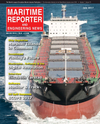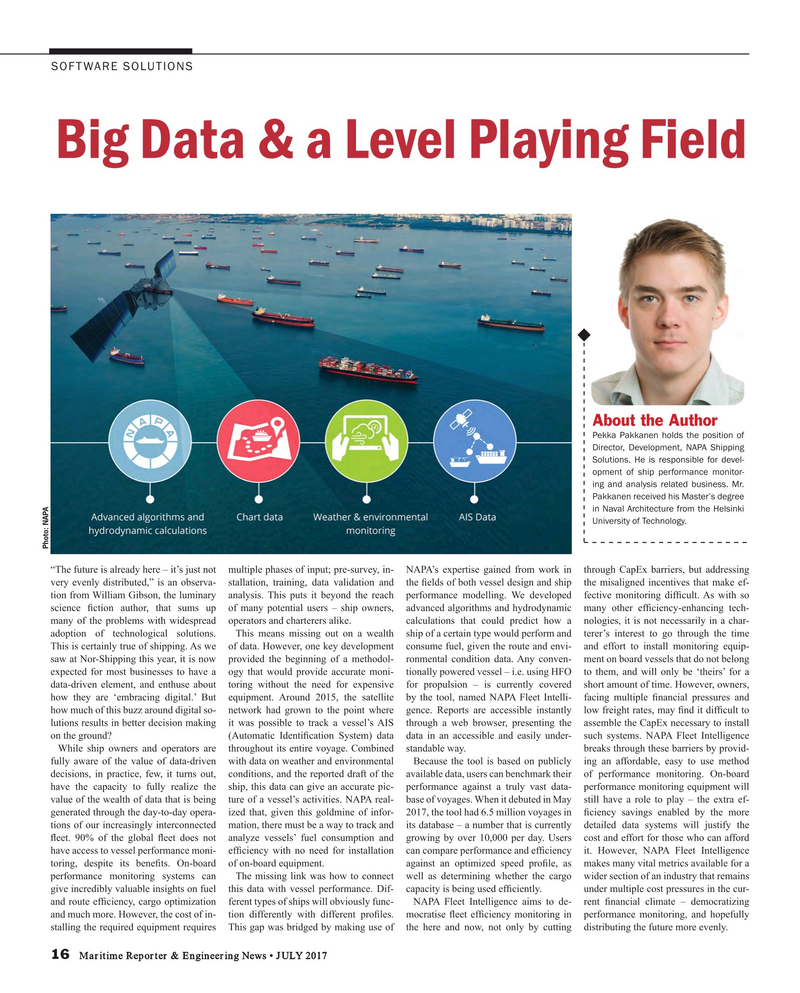
Page 16: of Maritime Reporter Magazine (July 2017)
The Marine Communications Edition
Read this page in Pdf, Flash or Html5 edition of July 2017 Maritime Reporter Magazine
SOFTWARE SOLUTIONS
Big Data & a Level Playing Field
About the Author
Pekka Pakkanen holds the position of
Director, Development, NAPA Shipping
Solutions. He is responsible for devel- opment of ship performance monitor- ing and analysis related business. Mr.
Pakkanen received his Master’s degree in Naval Architecture from the Helsinki
University of Technology.
Photo: NAPA “The future is already here – it’s just not multiple phases of input; pre-survey, in- NAPA’s expertise gained from work in through CapEx barriers, but addressing very evenly distributed,” is an observa- stallation, training, data validation and the ? elds of both vessel design and ship the misaligned incentives that make ef- tion from William Gibson, the luminary analysis. This puts it beyond the reach performance modelling. We developed fective monitoring dif? cult. As with so science ? ction author, that sums up of many potential users – ship owners, advanced algorithms and hydrodynamic many other ef? ciency-enhancing tech- many of the problems with widespread operators and charterers alike. calculations that could predict how a nologies, it is not necessarily in a char- adoption of technological solutions. This means missing out on a wealth ship of a certain type would perform and terer’s interest to go through the time
This is certainly true of shipping. As we of data. However, one key development consume fuel, given the route and envi- and effort to install monitoring equip- saw at Nor-Shipping this year, it is now provided the beginning of a methodol- ronmental condition data. Any conven- ment on board vessels that do not belong expected for most businesses to have a ogy that would provide accurate moni- tionally powered vessel – i.e. using HFO to them, and will only be ‘theirs’ for a data-driven element, and enthuse about toring without the need for expensive for propulsion – is currently covered short amount of time. However, owners, how they are ‘embracing digital.’ But equipment. Around 2015, the satellite by the tool, named NAPA Fleet Intelli- facing multiple ? nancial pressures and how much of this buzz around digital so- network had grown to the point where gence. Reports are accessible instantly low freight rates, may ? nd it dif? cult to lutions results in better decision making it was possible to track a vessel’s AIS through a web browser, presenting the assemble the CapEx necessary to install on the ground? (Automatic Identi? cation System) data data in an accessible and easily under- such systems. NAPA Fleet Intelligence
While ship owners and operators are throughout its entire voyage. Combined standable way. breaks through these barriers by provid- fully aware of the value of data-driven with data on weather and environmental Because the tool is based on publicly ing an affordable, easy to use method decisions, in practice, few, it turns out, conditions, and the reported draft of the available data, users can benchmark their of performance monitoring. On-board have the capacity to fully realize the ship, this data can give an accurate pic- performance against a truly vast data- performance monitoring equipment will value of the wealth of data that is being ture of a vessel’s activities. NAPA real- base of voyages. When it debuted in May still have a role to play – the extra ef- generated through the day-to-day opera- ized that, given this goldmine of infor- 2017, the tool had 6.5 million voyages in ? ciency savings enabled by the more tions of our increasingly interconnected mation, there must be a way to track and its database – a number that is currently detailed data systems will justify the ? eet. 90% of the global ? eet does not analyze vessels’ fuel consumption and growing by over 10,000 per day. Users cost and effort for those who can afford have access to vessel performance moni- ef? ciency with no need for installation can compare performance and ef? ciency it. However, NAPA Fleet Intelligence toring, despite its bene? ts. On-board of on-board equipment. against an optimized speed pro? le, as makes many vital metrics available for a performance monitoring systems can The missing link was how to connect well as determining whether the cargo wider section of an industry that remains give incredibly valuable insights on fuel this data with vessel performance. Dif- capacity is being used ef? ciently. under multiple cost pressures in the cur- and route ef? ciency, cargo optimization ferent types of ships will obviously func- NAPA Fleet Intelligence aims to de- rent ? nancial climate – democratizing and much more. However, the cost of in- tion differently with different pro? les. mocratise ? eet ef? ciency monitoring in performance monitoring, and hopefully stalling the required equipment requires This gap was bridged by making use of the here and now, not only by cutting distributing the future more evenly.
16 Maritime Reporter & Engineering News • JULY 2017
MR #7 (10-17).indd 16 MR #7 (10-17).indd 16 7/6/2017 11:02:24 AM7/6/2017 11:02:24 AM

 15
15

 17
17
